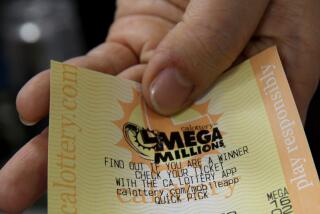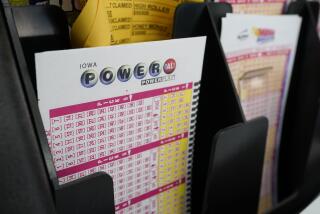California Lottery is booming, creating more players — and excitement
- Share via
After years of decline, the California Lottery is booming. The jackpots are bigger, and that’s drawing more players and excitement.
Just a few weeks ago, a Mega Millions ticket sold in San Jose matched all six numbers. The state-record prize of $324 million — worth about $174 million in a single payment — was claimed by a Northern California man Friday.
The turnaround is due to changes made to the lottery in 2010, when revenues were on the decline. The changes brought bigger prizes, but they also altered the formula for how much revenue schools receive.
And the long-term effect of those changes is far from clear.
Before the switch, the lottery’s contribution to public education was required to be at a minimum 34% of its revenue. The percentage of money going to prizes was capped at 50%.
But some officials believed the prizes were too small to draw more players. The state Legislature’s changes gave the lottery flexibility in determining its education contribution. That allowed the lottery to pump more of its revenues back into the prize pool, which officials say fueled the resurgence that continues today.
With lottery revenue booming, the money sent to schools has increased. In the 2011-12 fiscal year, the lottery wrote a check of $1.3 billion to California public education, the 12th straight year that the lottery contributed more than $1 billion.
But the gap between the share of lottery revenue going back to prizes and the percentage sent to public education is widening, according to audited financial reports the lottery publishes on its website.
In 2011 and 2012, the two years since the changes were approved, the lottery returned 55% and 59% of its revenue back to the prize pool. In that same period, 32% and 30% of lottery revenue was given to schools.
When California voted to establish a lottery in 1984, it was done in the name of helping schools. When the lottery had its third straight year of declining revenue in 2009, Assembly Bill 142 was passed as an urgency measure because the lottery’s education funding was slipping.
“The entire reason we exist is to supplement public education funding,” California Lottery spokesman Russ Lopez said. The bill “was critical for the growth of the lottery.”
Although the prize money has moved in line with the influx of new revenue, the education money has not and is not required to.
The new allocations do not explicitly state a percentage that must be given to schools, only that it must be higher than the amount given in 2009 and rise slightly every year. If neither condition is met, the allocation structure reverts to the pre-2010 percentages.
With the changes, which now mandate that at least 50% be returned to the prize pool, the lottery has seen an influx of cash. Its revenue grew 42% to top $4 billion in the two years-plus since the bill was passed.
Players have seen their potential winnings jump 59%, and retailers that provide lottery games have seen 38% more money. At the same time, education funding is up 21%.
In addition to the SuperLotto Plus game and Mega Millions, California became the latest state to join Powerball, just in time for a record prize that nearly touched 10 digits in May.
“Once we changed those [allocations], the frenzy begins,” Lopez said.
The bill was passed with overwhelming support from the Legislature. It was backed by former Supt. of Public Instruction Jack O’Connell, retailers and a company that provides lottery gaming technology.
O’Connell said that although he played no part in the drafting of the bill, he was happy to hear that the changes would result in more money for education. The changes were proposed during a time of declining state funding for schools and every bit mattered, no matter how small.
“We were trying to be creative as possible to generate additional revenue,” O’Connell said.
The lottery is a small part of education funding, akin to what a bake sale provides for an elementary school. About 1% of education funding comes from the lottery, supplementing contributions from the state’s general fund and other sources.
K-12 schools get about 80% of the share, money that doesn’t often go to helping students. According to a report from the California Department of Education, most lottery funds given to K-12 schools are used to pay salaries and benefits.
Schools also hit the jackpot when winners don’t come forward. The lottery forwards to education the cash value of any prize that goes unclaimed for 180 days. Last year, an extra $20 million from winners who didn’t cash in went to schools.
More to Read
Sign up for Essential California
The most important California stories and recommendations in your inbox every morning.
You may occasionally receive promotional content from the Los Angeles Times.











